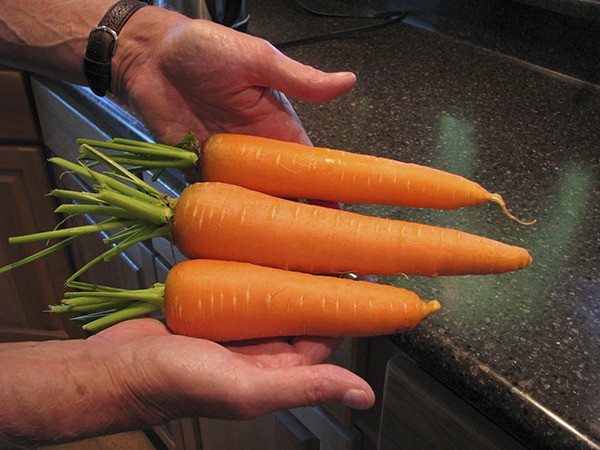Carrots grow well in the cooler climate of the Olympic Peninsula and also tolerate occasional warmth. Optimum carrot color and sugar is obtained when temperatures range between 60 to 70 degrees F.
The orange color of carrots comes from carotene, which also provides vitamin A. Most home gardens use Imperator-Nantes cultivars including Bolero, Mokum or Presto that produce carrots that are 8 to 10 inches long and 1-1/2 inches in diameter.
A carrot site needs full sun for 4 to 5 hours each day. Carrots grow deep into the ground. The site should have loose fine-grained soil with significant organic material that is 12 to 16 inches deep. Clay soil that sticks together or soil with clumps, twigs, rocks and other impediments will cause the carrot to deflect into a forked or truncated root. Remove soil impediments by screening.
Double digging loosens the soil for carrots. Dig the first 6 to 8 inches, set it aside, and add compost and peat moss. Then dig the lower 6 to 8 inches and replace it with the completed first course. Add compost and peat moss to the lower soil and put it back on top.
Deep raised beds also are a good place to grow carrots. Carrots do not need to be fertilized.
Get rooted
Carrots can be planted from late April through early August. Space rows 6 to 10 inches apart and seed every 2-1/2 to 3 inches along the row. To provide ongoing fresh carrots, plant seeds every 3 weeks. Planting can be done by hand, seeding into a shallow 1/4-inch trench at 2 to 3 seeds per inch, or by creating seed tapes (see sidebar) yielding a 2-1/2 to 3 inch final spacing. Hand sowing will require thinning to 2-1/2 to 3 inches apart when the plants reach 3 inches tall. Seed tapes do not need thinning. Both seeds and tapes should be covered with 1/4 inch or less of soil.
Once planted the seeds must be kept moist using frequent short watering cycles until the carrot greens are 6 inches tall. After the carrots grow 6 inches tall, water twice a week 1/2 inch each time. Drip tape or quarter-inch tube with drip holes at 6 to 9 inch spacing, placed between two rows is adequate to dispense water. Do not water during heavy rain periods.
Harvest time
Harvest is 65 to 80 days from planting. Some carrots can be left in the ground during mildly freezing weather until several days of low 20s are experienced. Any frozen carrots should be harvested to prevent them from rotting. In warmer weather, avoid scalded tops on mature carrots by mounding soil around the carrots tops.
Early carrot plantings should be covered with row cover to prevent carrot rust fly and other flying predators from laying eggs in the soil. The larvae of these pests will eat the roots. The pest’s first hatch is from late April through May. Preventing the first hatch eliminates later hatches, so be sure to use row cover. Reduce the occurrence of rust fly by eradicating Queen Anne’s Lace (wild carrot) from the garden site.
Maybe this is the year you should add a new crop to your home garden. The Olympic Peninsula really is a great place to grow carrots!
John D. Norgord is a Washington State University-certified, Clallam County Master Gardener.



